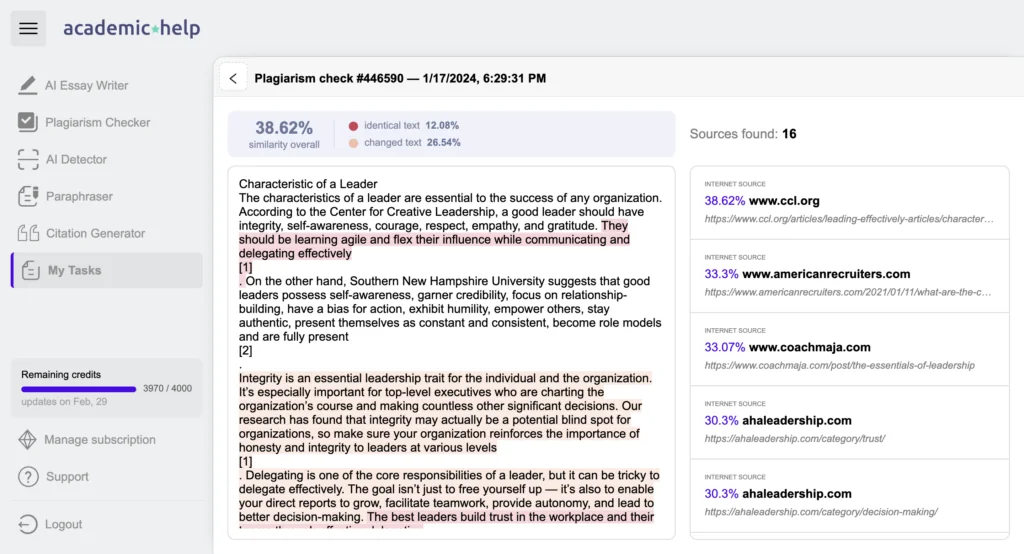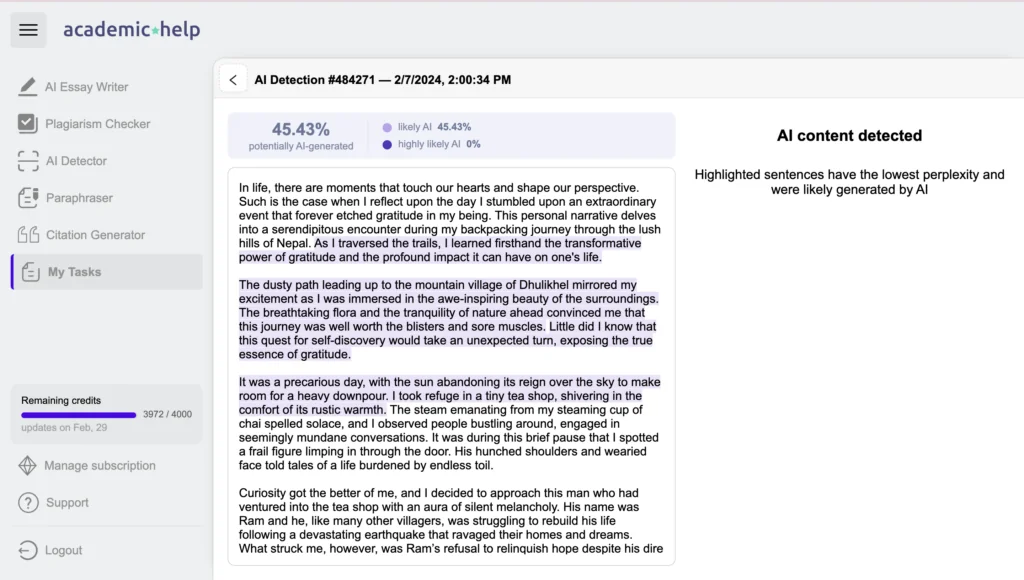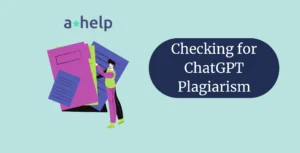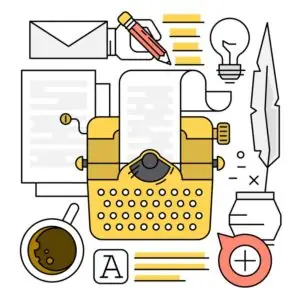With the rising accessibility of AI tools designed to assist with content creation, people get seriously concerned about academic integrity. We are here to answer a pressing question: Does working with AI for academic purposes slowly but surely get you into the murky waters of plagiarism?

✅ AI Essay Writer ✅ AI Detector ✅ Plagchecker ✅ Paraphraser
✅ Summarizer ✅ Citation Generator
Issues with AI Content and Plagiarism
We all know by now that creating content with the assistance of AI tools is a relatively straightforward process. By inputting prompts or guidelines, students can generate essays, reports, and research papers in a fraction of the time it would take to write them manually. However, this convenience raises significant concerns about plagiarism. The primary issue lies in the origin of AI-generated content.
How AI Content Creators Work?
AI tools, built on the principles of artificial intelligence and machine learning, operate by digesting and analyzing extensive collections of digital content. These collections have a wide array of sources, including books, articles, websites, and other forms of media, encoding human knowledge and expression into their algorithms. When a student inputs a prompt or set of instructions, the AI tool processes this input through its trained model, generating content that aligns with the given parameters.
Original Piece of Information: “The theory of relativity, proposed by Albert Einstein in the early 20th century, revolutionized our understanding of space, time, and gravity. It consists of two parts: the special theory of relativity and the general theory of relativity. The special theory of relativity, published in 1905, introduced the idea that the laws of physics are the same for all non-accelerating observers, and that the speed of light within a vacuum is the same no matter the speed at which an observer travels. The general theory of relativity, published in 1915, expanded on this by proposing that gravity is the effect of the curvature of spacetime caused by mass and energy. Einstein’s theories challenged conventional wisdom and laid the groundwork for modern physics.”
AI-Generated Content Based on the Original: “Albert Einstein’s theory of relativity, unveiled in the 20th century, fundamentally altered our grasp of the cosmos, intertwining the concepts of space, time, and the force of gravity. This groundbreaking theory is divided into two segments: the special and the general theories of relativity. In 1905, Einstein introduced the special theory of relativity, positing that physical laws remain constant across all non-accelerating frames of reference and that light’s velocity in a vacuum is unaffected by the observer’s velocity. A decade later, the general theory of relativity built upon this foundation, suggesting that the presence of mass and energy warps the fabric of spacetime itself, leading to the phenomenon we perceive as gravity. These propositions not only defied the traditional views of physics but also provided the cornerstone for the development of contemporary physics.”
The technology behind these AI models is both sophisticated and powerful. Algorithms such as GPT (Generative Pre-trained Transformer) use deep learning techniques to understand context, mimic writing styles, and produce text that can be remarkably coherent and nuanced. This capability stems from their design to predict the next most likely word or sentence based on the input and the data they’ve been trained on, allowing them to generate essays, reports, and research papers from relatively simple prompts.
The Visible Drawbacks of Such “Work”
The efficiency and sophistication of AI content creation tools do not come without their drawbacks, especially concerning plagiarism. The core of the issue lies in the nature of the content these AI tools produce. Given that the models are trained on existing online material, the generated content, while unique in composition, is derivative in essence. It reflects patterns, ideas, and sometimes specific phrases from the corpus of data it has learned from. This raises questions about the originality of AI-generated content and whether it constitutes plagiarism if the AI inadvertently produces work that closely mirrors existing copyrighted material without appropriate citation.
AI Content in Academia
The challenge grows because AI can easily create work that looks original. This might lead students to overuse AI for making content, which could reduce how much they engage with their studies and weaken their ability to think critically and write effectively. It’s becoming harder to tell the difference between getting ideas from AI and just copying what it produces. This confusion not only makes it tough to define what counts as plagiarism with AI but also brings up worries about whether the work is genuinely the student’s own. Both students and teachers might start to wonder if the assignments they turn in truly represent their own knowledge and effort or just show how well AI can put together information.
Furthermore, the rise of AI-generated content impacts the process of plagiarism detection too. Traditional plagiarism checkers are designed to check Сhat GPT and find direct matches or close paraphrases between a student’s submission and existing published works. However, the complex and diverse output from AI tools can often slip past traditional plagiarism checkers, particularly when the AI-generated content doesn’t exactly copy but closely follows the structure or ideas of the original sources. This situation makes it tougher to uphold academic honesty, highlighting the need for better plagiarism detection techniques that can handle the specific challenges introduced by AI-created content.
Is AI Content Ethical?
The ethical implications of using AI-generated content in academic settings hinge on two main considerations: the originality of the work produced and the intent behind its use. In essence, if a student passes off AI-generated content as their own original thought without proper citation, it not only breaches academic integrity policies but also undermines the value of learning and intellectual growth. Such actions can be viewed as unethical, as they compromise the principles of honesty, fairness, and respect for the intellectual contributions of others.
In the academic world, using AI to create content needs to be handled with care to make sure it doesn’t break ethical rules. Schools all over the world are working through these issues, trying to update their rules to include AI in education while making sure that the fundamental principles of academic honesty are protected.
How to Avoid Plagiarism When Using AI
Minimizing the impact of AI on plagiarism levels in your work involves a conscientious approach to content creation. Here are some strategies to humanize and personalize AI-generated content, ensuring it meets the standards of originality and integrity:
- Cite AI Contributions: Acknowledge the use of AI tools in your work, similar to citing any other source. This transparency helps delineate your own insights from AI-generated content.
- Enhance and Edit: Use AI-generated drafts as a foundation, then critically review and modify the content to reflect your understanding, voice, and critical thinking. This process not only enriches the work but also embeds your personal intellectual engagement with the subject matter.
- Cross-Check for Originality: Leverage plagiarism checkers to verify the uniqueness of your AI-assisted work. This step is crucial in identifying and rectifying any inadvertent overlap with existing material.
AI Detectors and Plagiarism Checkers
In response to the proliferation of AI-generated content, a new generation of tools has emerged, designed to distinguish between human and AI writing. These AI detectors, alongside any traditional AI generator checker, serve as allies in maintaining academic integrity.
Plagiarism checkers scan documents against a vast database of published work to identify duplicate content.

On the other hand, AI detectors analyze writing patterns and stylistic nuances to flag content that may have been machine-generated

For students, understanding and utilizing these tools can be invaluable. They not only aid in ensuring the originality of your work but also offer a means to self-assess the authenticity and ethical standing of your academic endeavors.
Conclusion
The intersection of AI-generated content and plagiarism presents a complex challenge, poised at the crossroads of innovation and ethics. While AI tools offer unprecedented opportunities for enhancing academic work, they also necessitate a heightened awareness and proactive measures to uphold the principles of academic integrity. As we navigate this evolving landscape, the onus falls on students, educators, and institutions alike to foster a culture of honesty and responsibility, ensuring that the pursuit of knowledge remains both innovative and ethical. Ultimately, the relationship between AI content and plagiarism underscores the importance of mindful engagement with technology, where the tools at our disposal are used not as shortcuts, but as catalysts for deeper learning and intellectual exploration.
It all depends on how we use AI. It would be wise to use it more for streamlining writing processes and less for creating content itself. The standard for smart usage of AI tech in writing is this new AI checker for essays: it will revise your papers and provide valuable feedback, but not write the content for you.
FAQ
Follow us on Reddit for more insights and updates.





Comments (0)
Welcome to A*Help comments!
We’re all about debate and discussion at A*Help.
We value the diverse opinions of users, so you may find points of view that you don’t agree with. And that’s cool. However, there are certain things we’re not OK with: attempts to manipulate our data in any way, for example, or the posting of discriminative, offensive, hateful, or disparaging material.